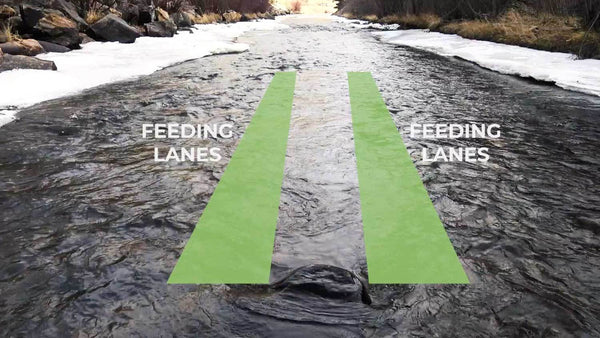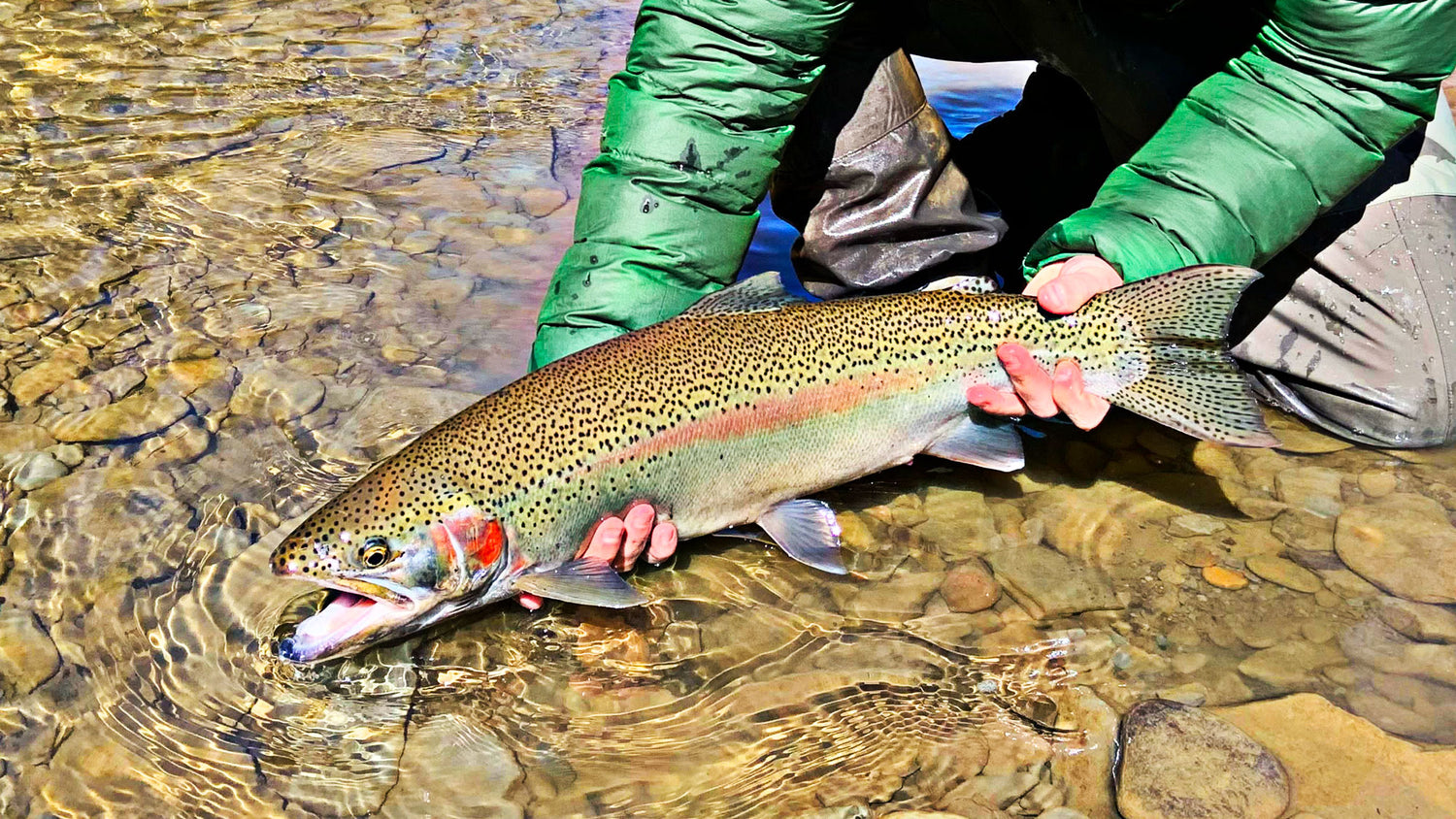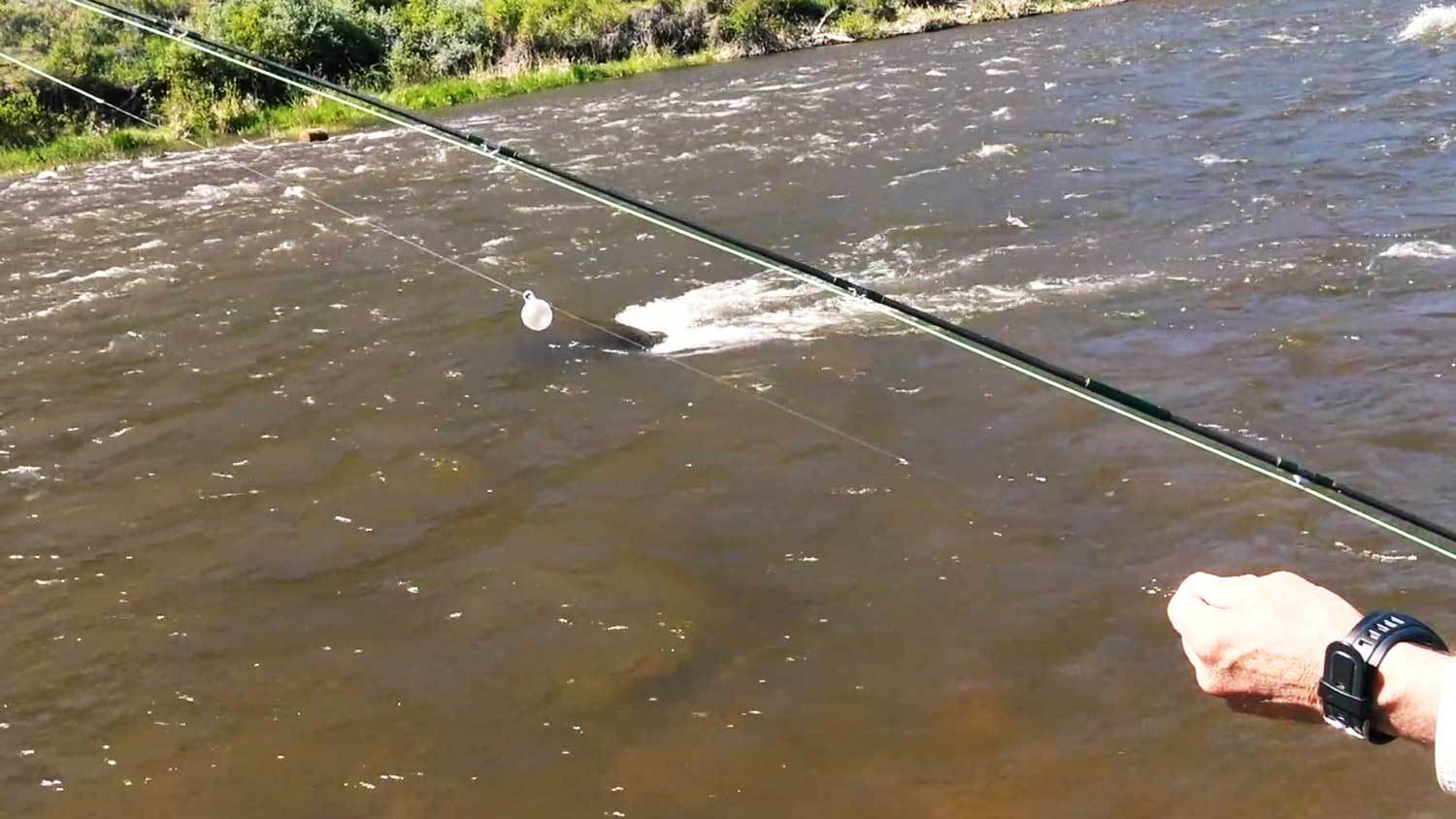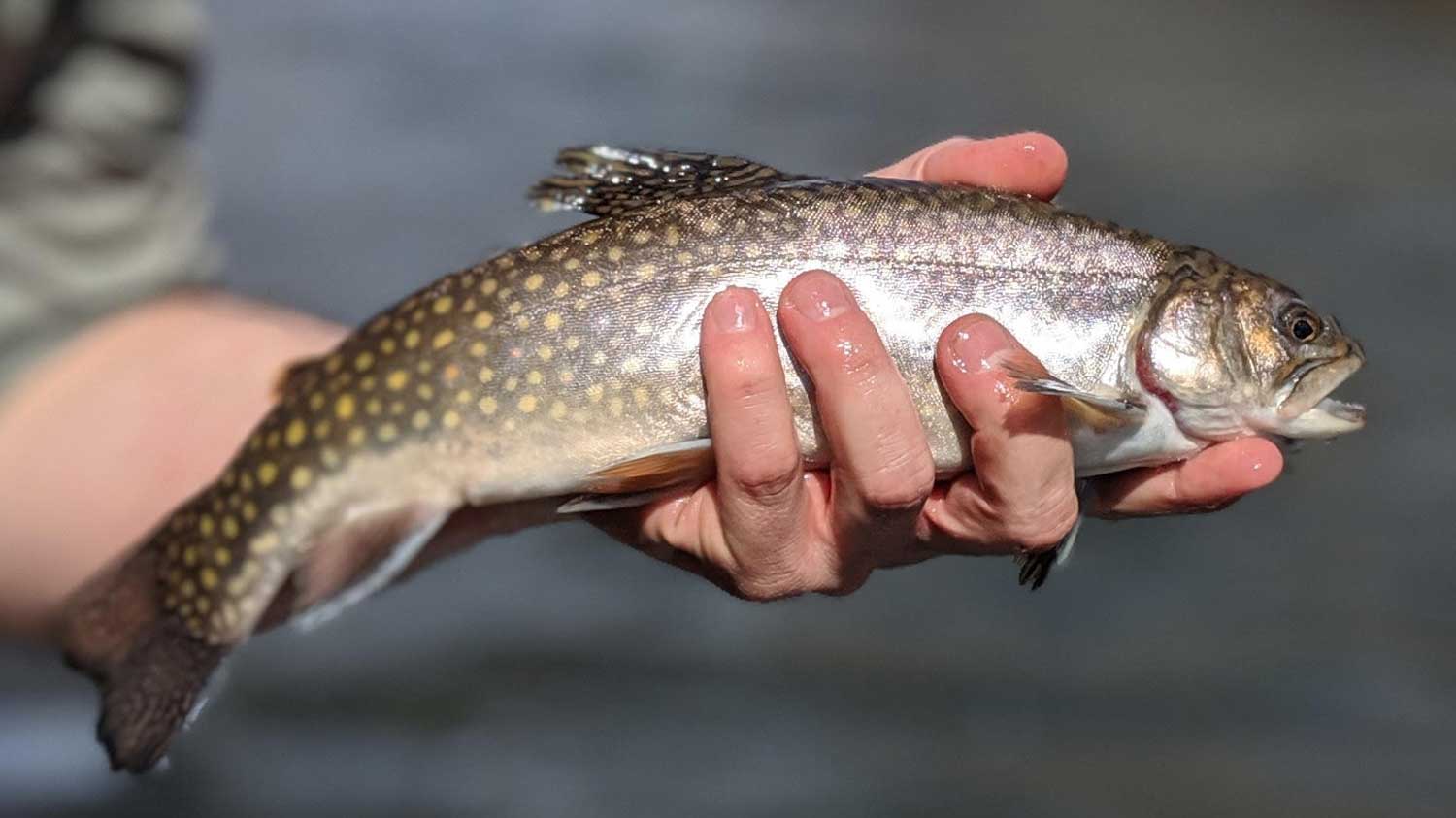There are many ways to fish for trout or steelhead during particular times of the year. Many anglers agree that using egg patterns is the most effective way, especially during the spawning season. They are an easy way to reel in a fish because eggs provide so many nutrients; it would be hard to pass up, scoring you the perfect catch. If this has you overwhelmed, and you do not know where to start, here is a guide to fly fishing with egg patterns.

Picking The Right Egg Pattern for Fly Fishing
The goal is to match the eggs with the specific prey it feeds on. Matching natural color combinations is crucial. Orange and light pink egg flys are some of the best colors, for they more closely resemble the real thing.
Eggs from spawning rainbow trout have a yellowish-orange color and are about 3/16 inches while eggs from spawning steelhead and Coho salmon have the same translucent color about ¼ inches. Chinook salmon eggs are the same color as well but are ⅜ inches. Unlike the rainbow trout, coho salmon, steelhead, and Chinook, brown trout's eggs are bright orange and are ¼ inches.

Another tip is to make sure you have different variations of colors within the oranges and light pinks. This also helps the egg look more realistic. Free drifting or trapped eggs stuck in gravel are in the water for a while, and it shows in their color. Their color becomes less vibrant and turns more translucent. After a while, it becomes completely opaque.
Having off-white or cream-colored eggs would also prove to be very useful in your fly fishing arsenal because these types of fly eggs naturally imitate those eggs that did not get fertilized. When the real eggs are not fertilized after they have been laid, their color becomes a whitish color, and it is murky instead of translucent. You should also consider having egg cluster patterns just in case you find yourself fishing in murky waters.

Most egg flies are made out of yarn and cut into an oval shape to resemble a natural egg, with a wide variety of colors. The most common colors used are peach, pink, orange, and yellow. The color you pick depends on where you are fishing as the best color to match is the most common natural eggs that populate the area where you will be fishing.

After you have found the right color and size for your fly eggs, another thing to do to maximize your chances of getting the egg pattern. The multicolor aspect of this egg pattern helps to better represent the eggs in their various stages while in the water. Together both colors are translucent in the water. It may look very light and weightless, but it sinks when in water. This egg pattern is best in a large size and used when the water is full of leaves and other debris.
Ragg Egg
This egg pattern is tied loosely to the hook. This type of pattern is commonly used with two egg flies. The larger egg fly is brighter in color. The other egg fly has a more realistic pattern and is smaller. It more closely resembles what might be in the water.
Glo Bug
This egg pattern is the most simple but still highly effective. The glo bug fly pattern is lightweight and will toss and turn with the water with ease. In order for it to get where the fish is, it is imperative to add enough weight either above it through the reel line or below.

Nuke Egg
The Nuke Egg pattern is considered among many anglers as a step above the original Glo Bug. It is tied imperfectly around the hook, giving off the appearance of a real egg when wet. The nucleus is covered under a veil of egg yarn, making it translucent underwater. It closely imitates a natural egg. You can mix up the different materials for the nucleus like McFly Foam, braids, chenille, or dubbing.
Sucker Spawn
This is another pattern that is effective when catching trout. The yarn pattern most closely resembles a clutch of fish eggs. Bright colored spawn is highly effective in catching steelhead. You can use whatever color you like, but most go for yellow, peach, and orange thread and yarn. Once you pick a thread color to serve as the nucleus, you tie a series of lops along the top part of the hook shank to create the cluster effect.
With all the different patterns, you have a couple of options for your hooks to choose from. Some hooks do not have anything attached to them, making them ideal for fishing near the top of the water. Beaded egg flies are ideal for getting fish near the bottom without adding too much weight because the bead's weight allows the fly to sink.

Fly eggs are only a part of a successful day on the lake or river. But all of the preparation will be in vain if you do not consider the time of year to fly fish eggs. Keep in mind carp spawn from April to June in shallow waters, Brown trout spawn from October through December, Rainbow trout spawn from February through May, and Brook trout spawn from September into October.
When you are looking at spawning seasons, remember you will be fishing for the other fish that herd below the breeding grounds of the fish that is in the season to spawn. In an effort to being environmentally conscious, do not fish the breeding fish.
Leader Setups for Fly Fishing Egg Patterns
There are many different leader setups that can be used with fly fishing egg patterns but the one that I find most successful is a 2 fly Setup.

Nymph Leader – 2-Fly Setup - General Fly Fishing Adventure
- 9ft 4x leader
- Clear bobber indicator
- Splitshot – 2 to 3 size 4
- Fly #1 - Egg Pattern
- 12” to 14” 5x or 6x Tippet
- Fly #2 - Nymph Pattern
This fly fishing rig setup is used when nymphing moving water, such as a river or a stream. Weight can be added or removed depending on the depth of the feeding lane that you are fishing. For more extensive information on leader, set-ups check out our article on the subject here.
___________________________________
___________________________________

Indicators for Egg Pattern Fly Fishing
Indicators are used to keep track of where your line is underwater. There are many different styles that offer many different functionalities to help you with that successful catch. Here are some varieties of bobbers and indicators that are commonly used today.

Thingamabobber
This is extremely popular and easy to use. They come in four different sizes and multiple colors, ready to suit any situation you come across. The size of the thingamabobber depends on what you are trying to catch and the water you are in. For trout streams, typically ½ inch is best. You can graduate up to one inch or one and a half-inch bobbers for higher water and bigger fish.
They have great buoyancy and are super easy to see in the water. Bobbers are suitable for fishing from a drift boat and for faster, broken water, and heavy nymphs. They come in so many different colors besides the standard red or red and white that is commonly associated with these bobbers.
At the same time, bobbers are hard to adjust its placement on the leader, they can slide on thinner sections of tippet, sometimes they kink the leader, in windy weather, they are hard to turn over, they hit the water hard potentially scaring your catch, and they are difficult to lift off the water.
Air-Locks
These take the Thingamabobber to the next level. Air-locks are essentially a plastic nut that attaches itself to the leader, allowing for a quick and easy adjustment of its placement on the leader. If you need to go into more shallow or deeper waters, loosen the nut and slide the air-lock up or down. If you need a 90-degree bend in the leader, you can also thread the leader through the nut. Air-locks are suitable for faster, broken water and bigger fish. If you are fishing from a drift boat, using an air-lock is also ideal for that.
Air-locks have excellent buoyancy, and they are effortless to see. They hold onto the leader regardless of tippet diameter, are easy to adjust their placement, will not tangle the leader, and come in multiple colors and sizes. The bad thing about air-locks is that they are easy to lose the nut or washer that locks it down. They are hard to turn over in windy conditions, hit the water hard, and are difficult to lift off the water.
Palsa Pinch-Ons
These are extremely popular, primarily due to their ability to land softly. They are great for low and slow water as well as nymphing with smaller, lighter flies. Pinch-ons will not kink the leader, are easy to cast, and come in multiple colors and sizes. As an added feature, you can use two of them in tandem, creating a ling in your indicator. This will help you determine the angle and position of your flies.
The bad thing about pinch-ons is they are not environmentally conscious products as they are essentially one-use. It leaves a sticky residue on the leader and can be hard to see in faster-broken water. Its size makes it easy for it to ride lower than the water.

The Football
Just made of small pieces of slotted colored Styrofoam, these attach to your leader by a rubber band or toothpick. You do not have to go to sporting goods or specialty store to get these. You can pick them up from anywhere. It is very easy to adjust its placement on the leader, and they come in multiple colors and sizes. These are great for fishing from a drift boat in faster, more broken water and more massive fish.
The Football indicator is not all good. They can hit the water too hard, are difficult to pick up off the water, and eventually, the rubber band or toothpick will break or misplaced.

Yarn Indicators
As the name indicates, these are made out of yarn. They are ideal for fishing in crystal clear water. These indicators are super light when thrown into the water, making yarn indicators ideal for catching trout that are easy to scare. These are best for clear, skinny water and for catching small to medium weighted nymphs and high strung trout, They are easy to see, easy to turn over and pick up, and comes in a variety of colors and sizes.
For them to work efficiently, you have to dress them with floatant, and because they are so light, they can get quickly drug down in quicker currents.
Pinch On Indicator Putty
This is an excellent alternative for those who do not find other indicators or bobbers helpful. This also gives you more control in the way your indicator looks. To get a perfect size, you can add or take away putty. These are also more environmentally friendly because they are biodegradable.
Pinch on putty indicators are suitable for small to medium nymphs in slower currents, riffles, and runs as well as night fishing. They are awesome for night fishing because the putty comes in a variety of colors, including glow-in-the-dark. They are easy to see, easily adjustable for placement on the leader, and it will not kink your leader.
There are some things to keep in mind when using pinch on putty. They can fall off on occasion, they are not very buoyant and can get dragged down in faster currents, are kind of heavy and awkward to turn over large amounts, and can leave a sticky residue on your leader and fingers.

It is best to carry multiple types of indicators and colors so you can always be prepared for any kind of day or clarity of the water. Vibrant colors are useful when the sun is glaring off the water or if the water is fast-moving. White and clear indicators are also encouraged to use as they more easily blend into bubble lines and are less likely to scare the fish.
Be wary of placing your indicator too far up the leader. This can cause your nymph to drift where you do not want it and create a delay in transmitting the take to the indicator and missing more hooksets. As a rule of thumb, place your indicator about one and a half times the water's depth up to your leader from the bottom fly.
Casting Techniques for Fly Fishing With Egg Patterns
There are many different casting techniques you can use to catch your fish. The basic cast is the ¾ up and across the current cast. This will land your fly upstream of your target. This is good because it will not scare the fish and allow the proper amount of time for your fly to sink to the required depth.

When the egg fly tumbles downstream, you should gather the slackline and make sure the rod tip follows the indicator downstream. Once it comes downstream, lift the rod tip slowly and allow the fly to swing out of the current. Repeat this process until you have done your entire area.
A good tip is to position yourself near the head of the long run of the riffle. Allow your flies to long-line drift the entire run downstream. Your cast length should be as long as you can accurately handle upstream without letting excess slack build up. Too much line upstream makes it challenging to set the hook on strike from fish.
Another essential tip to remember is to set your hook and set it quickly. To do this, you should sweep the rod low and to the side, followed with a quick stout hook-set at the end of the sweep. Make sure to look out for brush, or if you are with a fishing partner, make sure you look out for them. The water current will create tension, allowing you to set the fly in the fish's mouth.
Finding Fish when Fly Fishing Egg Patterns
Trout can be found in still waters like lakes and ponds. When searching for trout in lakes and ponds, you should look near or above aquatic vegetation, around logs, stumps, rocks or other structures at stream inlets were streams flowing into the lake or pond are bringing freshwater, and deeper waters especially in the summer months when trout are looking for colder waters. The best time to trout fish in lakes and ponds is in the spring and fall when the water is colder. The trout are more active during this time. You can still fish for trout in the summer months, but you have to look in deeper waters or in high mountain lakes that stay cool all year round.

You can also find trout in rivers and streams. They typically camp out in one spot and wait for the food to come for them. Most of the time, these fish eat aquatic insects. You can look for them behind rocks or other structures, near steep or undercut banks, and in deeper slower pools. When looking behind rocks, make sure you are on the lookout for where the surface is textured with bumps or riffles. Yes, the best time to fish for trout in streams and rivers in the spring and fall when the water is cooler.
For an extensive lesson on finding the feeding lanes of trout check out our video on reading the water.
About the Author
Matthew Bernhardt, a third-generation Coloradan, grew up at the forefront of the state’s fly-fishing revolution, enjoying time on the water side by side with experienced guides and lifelong anglers.
By combining his passion for fly-fishing with input from other experienced fly-fishers and guides and his fine arts degree from Colorado State University, Matthew spent five years carefully developing the Drifthook Fly Fishing System, built to help every angler catch more trout.
When he’s not spending time with his wonderful family, you’ll find him out on the water catching MONSTER trout, and he anxiously looks forward to the day when his kids are old enough to join him there.






